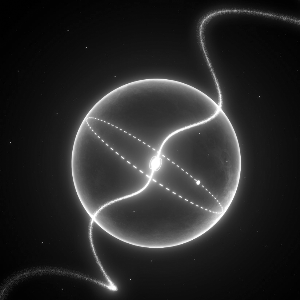 Next to a pulsar that constantly emits powerful radio waves, a giant diamond planet is spinning around it , a large discovery next to a pulsar near 4,000 light years.
Next to a pulsar that constantly emits powerful radio waves, a giant diamond planet is spinning around it , a large discovery next to a pulsar near 4,000 light years. If you are sitting in a spaceship and moving through the Milky Way, the ship's sensor may find a powerful radio wave that travels in the direction of the waves. The spacecraft is slowly approaching this unknown object. You finally discover that the powerful radio wave is not an abandoned spaceship, but an ultra-dense space composed of a huge neutron. Its size is only equivalent to one city, but the quality is The sun is so heavy!
This is a legacy left after the star dies, and it glows red at the end of life, and when it spins, it emits a powerful radio beam that is sent deep into the universe. This is a pulsar that emits a powerful pulse signal. However, this is not the most mysterious thing about this star's "body."
When you are about to turn the spacecraft ready to leave, you suddenly notice that there is something else in this neutron star system that shines red light. Looking closer, you will find that there is a celestial body next to it, the mass of which is as good as Jupiter, but not half the diameter of Jupiter. Why is it so heavy? You have used the detector to detect the composition of this celestial body. The result is a surprise to you. This pulsar is composed entirely of diamonds! Yes, in the long universe, you have encountered a diamond with a big planet.
This sounds like science fiction, but reality may be more magical than science fiction. In the universe, there is indeed a celestial body made up entirely of diamonds, which was recently discovered by scientists at Swinburne University of Technology in Melbourne, Australia. The discovery was published in the recent issue of Science.
Scientists first detected the pulse signal of this pulsar in 2009 with the help of a radio telescope in Australia. A month later, the Rover radio telescope revealed that there is a planet-like weight on the edge of the pulsar. Orbital celestial body. The planet's celestial body orbits 600,000 kilometers from the pulsar, which is equivalent to 1.5 times the distance from the Earth to the moon.
However, this planet is not nearly 4,000 light years away from the Earth, equivalent to one-eighth the distance from the Earth to the center of the Milky Way.
Five times larger than Earth
Almost swallowed by a "partner"
The next question is critical, because the planet is running very close to the pulsar, which means it is in a very dangerous area, and gravity will tear it, but why is this planet intact?
If the planet is a giant gas planet like Jupiter, then part of its atmosphere is already in this gravitational danger field, and it should not survive the moment that scientists were discovered today. Based on this calculation, the planet should have a radius of less than 60,000 kilometers, which accounts for only 40% of Jupiter's width.
What does a planet that is as heavy as Jupiter, but only half the size, mean? It is definitely more compact than Jupiter.
The pulsar discovered by scientists is a millisecond pulsar with a very short period of only a few milliseconds. The generation of millisecond pulsars is generally related to two stars, and the other star is called the "accompaniment celestial body".
At present, 70% of the high-speed rotation pulsars discovered by people have a "combined celestial body" to provide their own rotation energy. The millisecond pulsar is a high-speed rotation. The pulsar discovered this time has to complete 10,000 rotations per minute, which means that it requires a lot of energy, which comes from the "associated celestial body".
That is to say, at the earliest time, such a celestial system had two stars, and at the end of life, its core became a pulsar under high-speed rotation. The other star expands into a red giant star as it approaches the end, and later evolves into a white dwarf star, which is the final product of the stellar evolutionary stage. It is extremely dense and becomes the "accommodating celestial body" of nearby pulsars. Provide the latter with the energy of rotation.
Most white dwarfs continue to revolve around high-speed pulsars after they are absorbed, and some are swallowed by them.
"The fate of a white dwarf depends on its mass and distance from the pulsar." Bayless, the chief scientist at Swinburne University of Technology, said that if the white dwarf is heavy and close to the pulsar, the two will merge into one and spiral. Rotate.
At present, scientists have discovered 180 high-speed rotating pulsars with white dwarfs, but only once with the celestial bodies being planets. The diamond planet discovered this time is the second time that a planet is found near the pulsar.
The scientist did not find other giant stars with celestial bodies next to the pulsar. Therefore, the planet is likely to be a white dwarf at first, but under the oppression of the pulsar, the "white dwarf" lost 99.9%. The original weight no longer has a nuclear reaction that can contribute to the birth of a star, so it becomes a planet.
This planet, transformed by stars, is five times the diameter of the Earth and 3000 times larger than the pulsar around it.
It may be older than the sun
Scientists believe that the super-high pressure of the pulsar makes the planet's carbon turn into a diamond.
Most of this peculiar planet may be carbon. Because it is not big enough, it is unlikely to produce substances heavier than carbon, and its density is extremely high, which means that it may not have the lighter substances hydrogen and helium like Jupiter.
The planet is as massive as Jupiter, and its gravity is certainly great, keeping it under intense pressure, which may cause the carbon to be crystallized and eventually become a diamond. The diamonds in the earth are also formed like this: under high pressure, the underground carbon turns into diamond.
"The history of this planet and its amazing density show that it is made of carbon, probably a huge diamond that rotates around the pulsar every two hours," Bayless said.
If it is really a huge diamond, will it shine like a diamond on earth? "It's just speculation now, but if you shine a light on it, I think it will shine like a diamond," said Metcalfe, a scientist at the National Center for Atmospheric Research in Boulder, USA. He also discovered a white dwarf star whose carbon in the center of the core was crystallized under high pressure, eventually forming a new planet, which is also a crystal structure, but not a diamond.
No one can imagine now what this diamond planet looks like. "What it looks like, I can't even guess." University of Manchester scientist Staples said, "I can't imagine a bright object in the universe."
"It may have been around for a long time, we just discovered it, it may be longer than the Earth and the Sun," said Australian National Telescope Authority astronomer Case, "I can only say that diamonds are really forever." Retain."
If this is really a planet-like diamond, how much will it cost? Moses Bache, chairman of the New York Diamond Exchange, said that he could not "evaluate" the biggest diamond ever, without seeing the quality of the diamond, but he said, "If there is a way to ship it to New York. To cut, we don't care if it comes from the earth or from space."
Cable tie is used to tie things together. According to the material, it can be divided into nylon cable ties, stainless steel cable ties, plastic-sprayed stainless steel cable ties, etc.; according to the function, it can also be divided into ordinary cable ties, retractable cable ties, label cable ties, heavy tension cable tie, etc. The cable tie is made of UL-approved nylon 66 material with a fire rating of 94V-2. It has the characteristics of acid resistance, corrosion resistance, good insulation, resistance to aging, light weight, safety, non-toxicity, and strong durability. Operating temperature is minus 40 to 90 degrees.



Cable Tie,Nylon Cable Tie,Plastic Cable Tie,Pound Zip Cable Ties
Behappy Crafts (suzhou)Co.,Ltd , https://www.haoyuebehappy.com
![<?echo $_SERVER['SERVER_NAME'];?>](/template/twentyseventeen/skin/images/header.jpg)